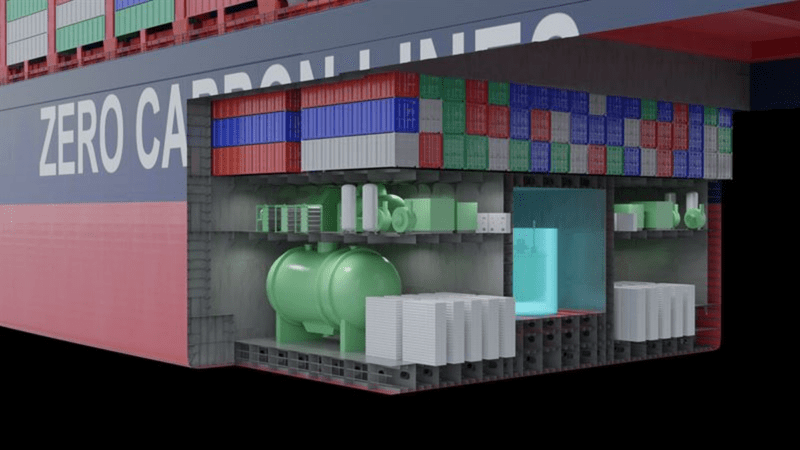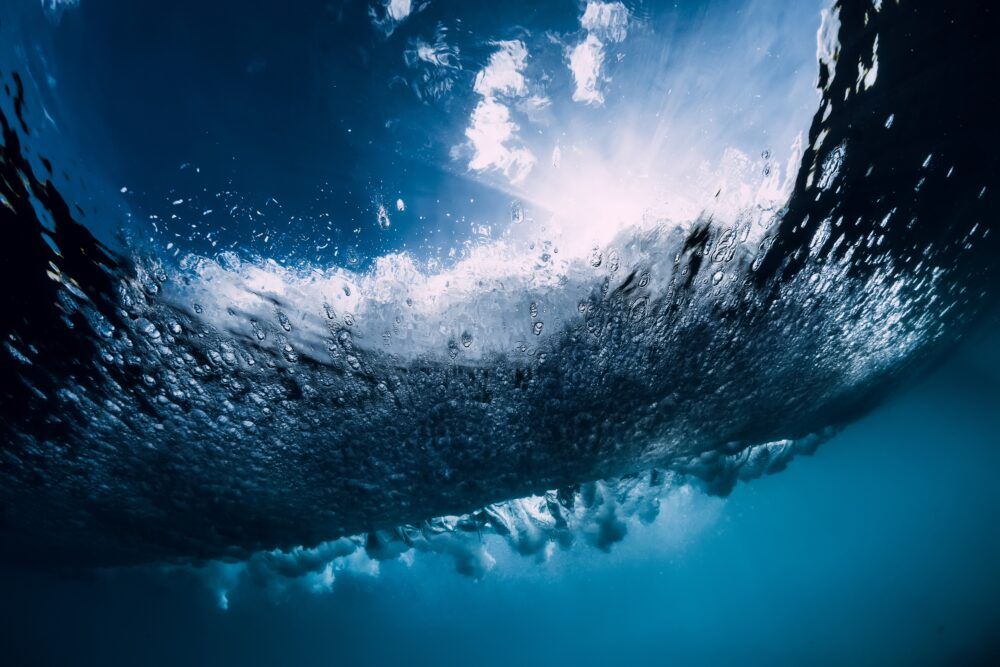
The European Ocean Pact: Ports as the New Blue Frontier
With the EU's European Ocean Pact, ports become key pieces for security, innovation and sustainable economy. Arnau Sedeño, researcher at CENIT, explains for PierNext the keys to Europe's commitment to a more resilient and strategic maritime future.

Predoctoral researcher at CENIT, with doctoral thesis focused on blue economy applied to the Port of Barcelona.

The Context of the Pact
The EU, on June 5, 2025, made public the European Ocean Pact, which seeks to accelerate the development of coastal areas so they are capable of withstanding the pressure to which they are being subjected as a consequence of the effects of climate change, pollution or overexploitation of marine resources, among others.
The importance of the pact is better understood if we take into account some data:
- The EU has around 70,000 km of coastline, and 40% of its population is located within the first 50 km adjacent to the sea line.
- The blue economy, linked to coastal waters, generates 5 million jobs and contributes more than 250 billion euros in gross added value to the EU's global economy.
- In addition, 74% of the EU's foreign trade is conducted via maritime routes and 99% of internet traffic is transferred through submarine communication cables.
And despite this increasingly intensive use, our oceans are still largely unexplored.
In recent years, we have seen how pressure on natural ecosystems has intensified. These changes will be accentuated in the coming decades, particularly on our oceans. Putting a brake on this implies rowing all in the same direction in order to protect our marine resources.
As Ursula von der Leyen, President of the European Commission, said: "We will strive to halve plastic and nutrient pollution within five years. We will restore natural habitats and protect our coasts more effectively from the impact of climate change. Our goal is to bring 20% of Europe's marine ecosystems back to life by 2030".
European Ocean Pact Perspectives
As Pablo Bou Mira, director of the BlueNetCatnetwork, explains to PierNext, "the Pact represents a step forward to have a more integrated vision of governance, innovation and research in the maritime field. Furthermore, it can help align efforts and avoid duplication of initiatives that are often carried out in an isolated or uncoordinated manner".
This pact has brought together guidelines regarding governance, innovation, investment and European diplomacy, encompassing these six priorities:
- Protect and restore ocean health
- Boost the sustainable competitiveness of the blue economy
- Boost research, knowledge, capabilities and innovation in relation to the ocean
- Support coastal and island communities and outermost regions
- Strengthen maritime security and defense as a prerequisite
- Strengthen the EU's oceanic diplomacy and international governance based on rules
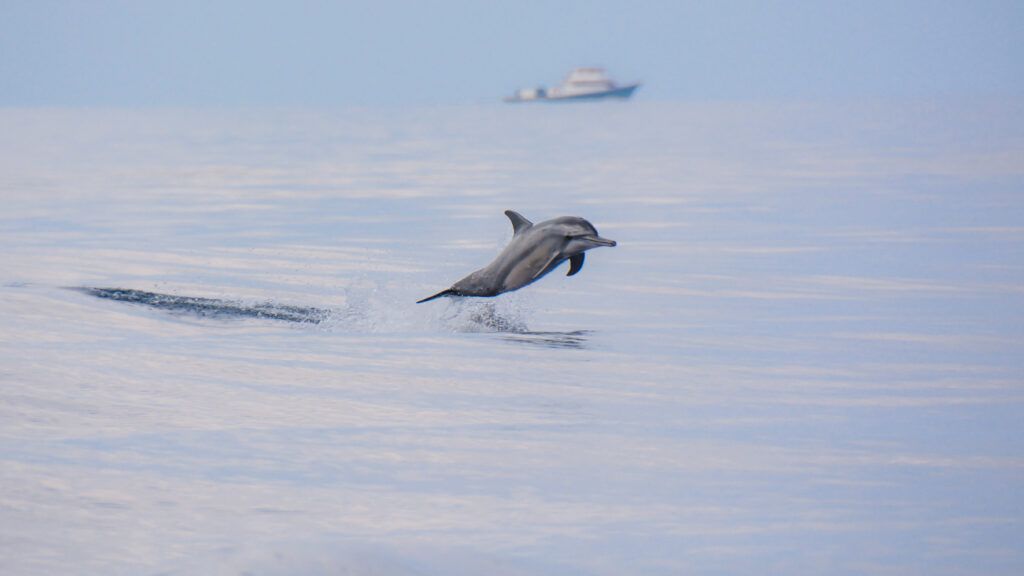
Protection and Restoration of Ocean Health
Firstly, for the protection and restoration of ocean health, initiatives are proposed such as increasing marine protected areas, habitat restoration, and active fight against marine and terrestrial pollution, in line with the EU Action Plan "Zero Pollution".
- Among the key actions is the revision of the Framework Directive on marine strategy to adapt it to new environmental challenges, promoting European blue carbon reserves as a climate mitigation tool, which will in turn generate new economic opportunities for coastal communities. Furthermore, it encourages Member States to designate and effectively manage Marine Protected Areas (MPAs), thus strengthening the conservation of marine biodiversity.
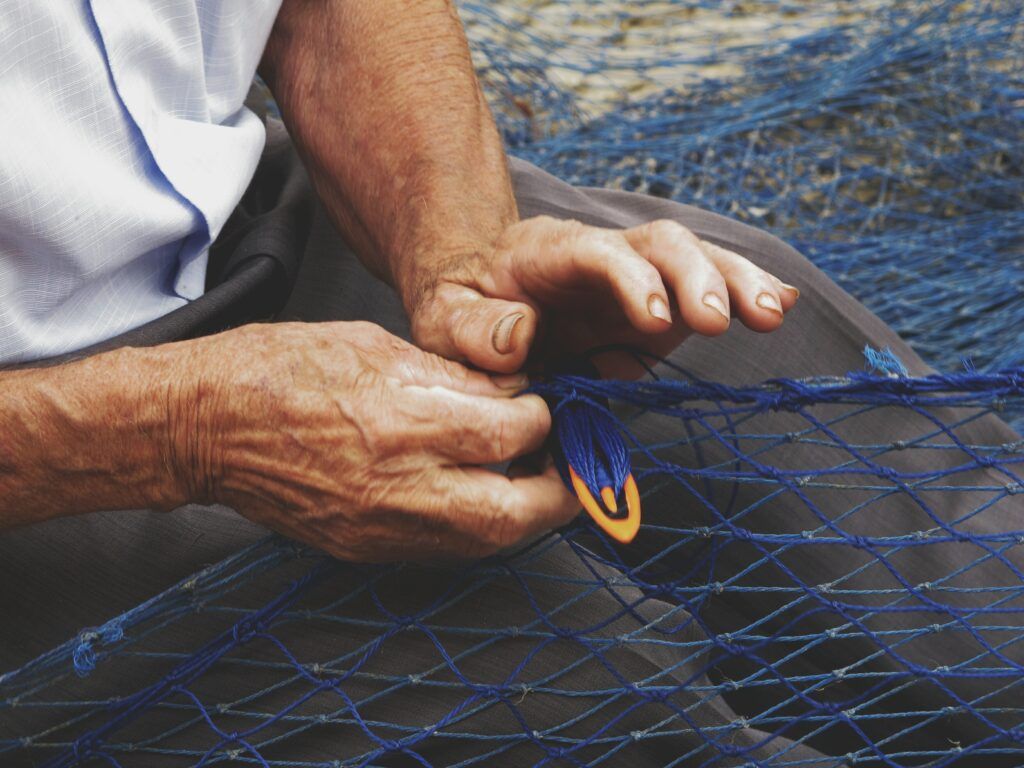
Boosting Sustainable Competitiveness of the Blue Economy
Secondly, to boost the sustainable competitiveness of the blue economy, traditional sectors such as fishing and aquaculture will be strengthened, also promoting emerging areas such as marine renewable energy, blue biotechnology and submarine robotics.
The evaluation and possible revision of the Common Fisheries Policy (CFP) to adapt it to new challenges is also contemplated, and a Vision 2040 for the future of fishing and aquaculture is defined, focused on sustainability and innovation.
Additionally, an industrial maritime strategy and a European port strategy are under discussion to drive sector modernization. Finally, a blue generational renewal strategy will be promoted, with the objective of attracting new generations to the marine-maritime sector.
But to achieve all this, as Bou warns, "currently funding is very fragmented, distributed among many small projects that do not generate sufficient impact. We lack effective coordination that allows articulating ambitious strategies".
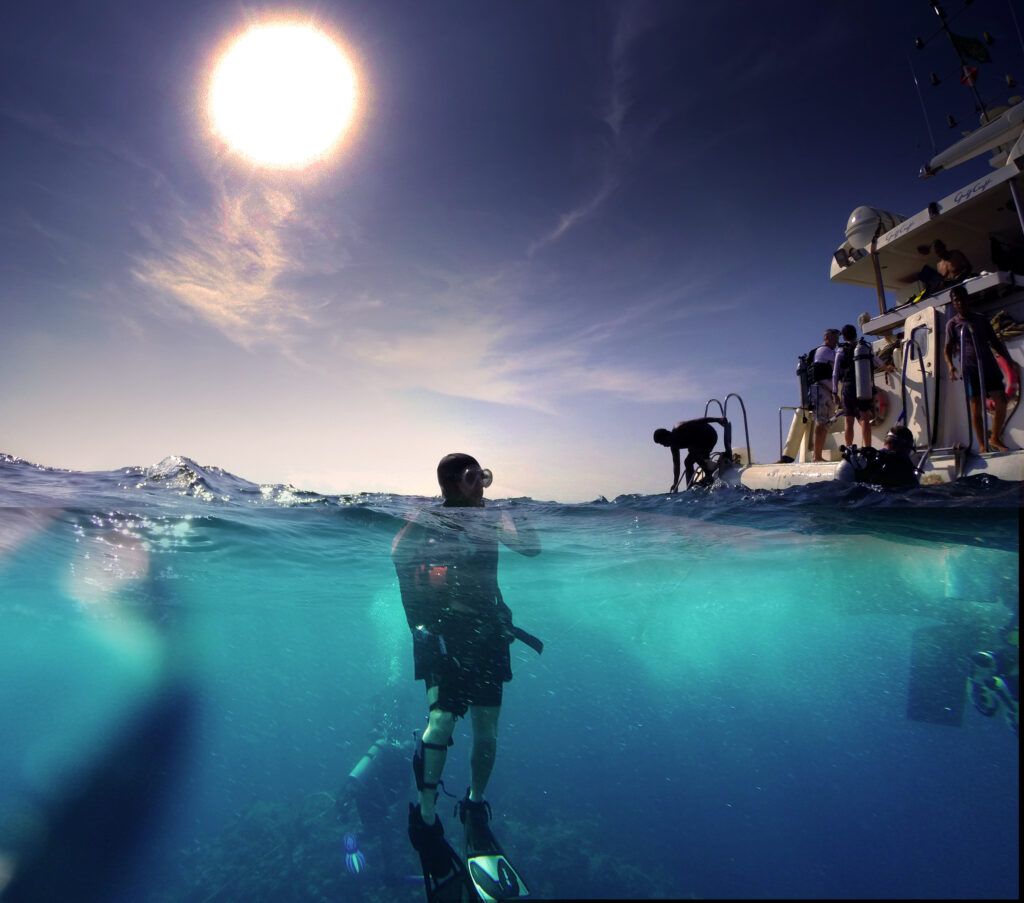
Research, Knowledge and Innovation
Thirdly, to boost research, knowledge, capabilities and innovation in relation to the ocean, among the highlighted actions, the ocean observation initiative and the creation of a digital replica of European seas will be promoted, before 2030. With this digital twin, it is intended to facilitate data for meteorological forecasting, in addition to mitigation strategies and facilitating adaptation to climate change, among others.
These actions are planned within the framework of the Decade of Ocean Sciences for Sustainability, "Decade of Ocean Science for Sustainability".
The Pact also contemplates international scientific cooperation with third countries, to complete a global ocean observation system. Its purposes will be to guarantee the availability of historical data, present a plan that maps knowledge gaps, develop an integrated high-technology observation system and create a coherent and standardized approach to plan and carry out ocean observation campaigns.
- It also proposes a European research and innovation (R&I) strategy on the ocean, which aims to bridge the gap between research and innovation. For this, financing for the development and application of new knowledge and solutions will be used, with a European network of ocean technology testing centers to accelerate this innovation and implement these key ocean technologies.
Through transdisciplinary approaches, solutions can be conceived to preserve the ocean and waters, incorporating participatory research and citizen participation.
Finally, it is intended to strengthen ocean literacy and citizen participation, with the creation of a Network of Youth and Intergenerational Ocean Ambassadors, and a new internship program in jobs that contribute to a competitive and sustainable blue economy.
As Bou explains, "from BlueNetCat we have a key role as a bridge between the political and institutional language of the European Commission and the reality of the territory. We translate these large frameworks so they are useful for local actors and we energize European projects at the Catalan scale".
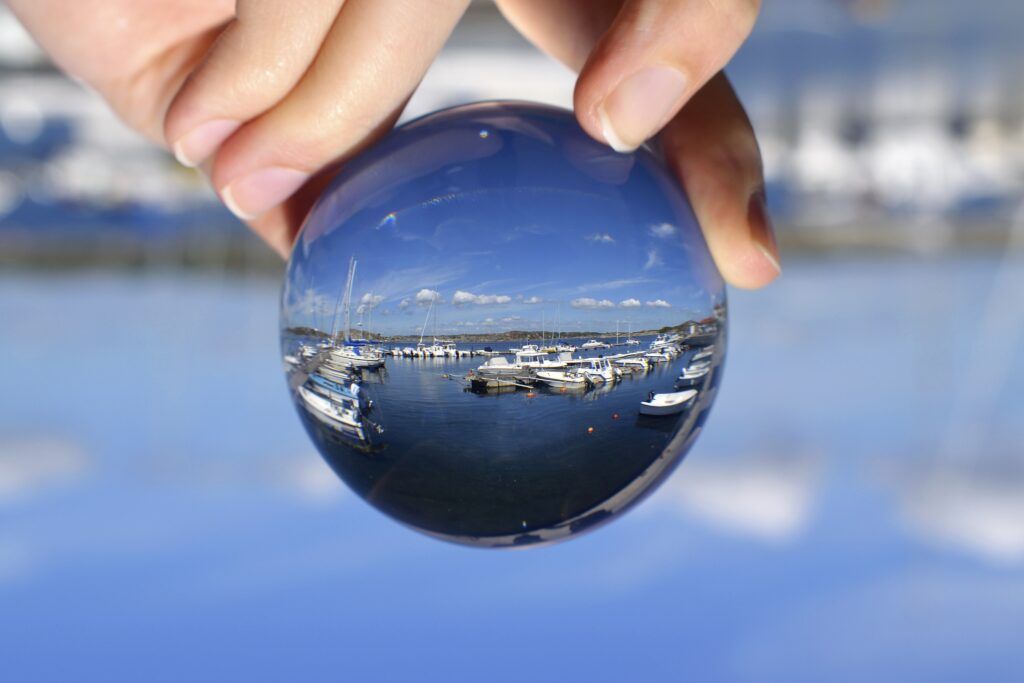
Supporting Coastal and Island Communities
Fourthly, it is intended to support coastal and island communities and outermost regions, through specific strategies that help these communities adapt to climate change and take advantage of new economic opportunities linked to the ocean. Among them, a specific strategy for the development and resilience of coastal areas stands out, along with a public consultation to develop a new strategy aimed at EU islands.
- In addition to updating the European strategy for outermost regions, guidelines on the balance of small fishing fleets (less than 12 meters) in these regions will be reviewed, in order to guarantee their sustainability and adaptation to local needs.
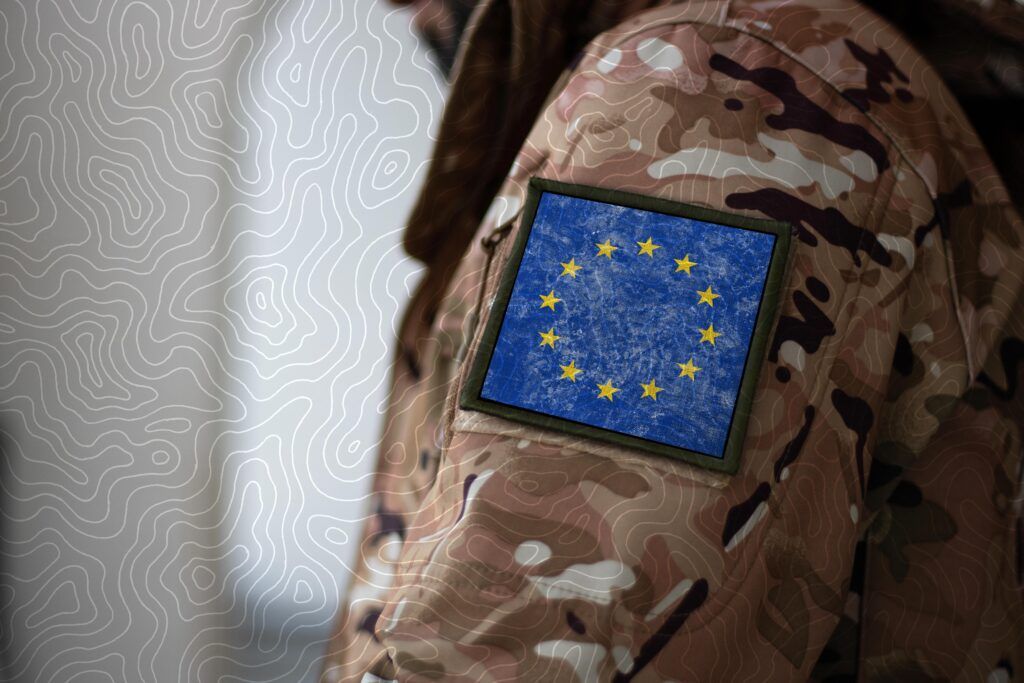
Strengthening Maritime Security and Defense
Fifthly, the European Ocean Pact seeks to strengthen maritime security and defense as a prerequisite, addressing emerging threats, such as cyberattacks and risks to strategic infrastructures, through cooperation at the European level and with third countries.
For this, it proposes a comprehensive strategy on unexploded ordnance (UXO), which integrates advanced detection and neutralization technologies. Closer cooperation with Arctic member states and other Arctic partners will be encouraged, and a European unmanned vehicle (UxV) fleet pilot project will be launched, both surface, submarine, and space vehicles, with state-of-the-art technological systems. Additionally, international cooperation with partner countries in North Africa and the Middle East will be reinforced, within the framework of strategic and global partnerships.
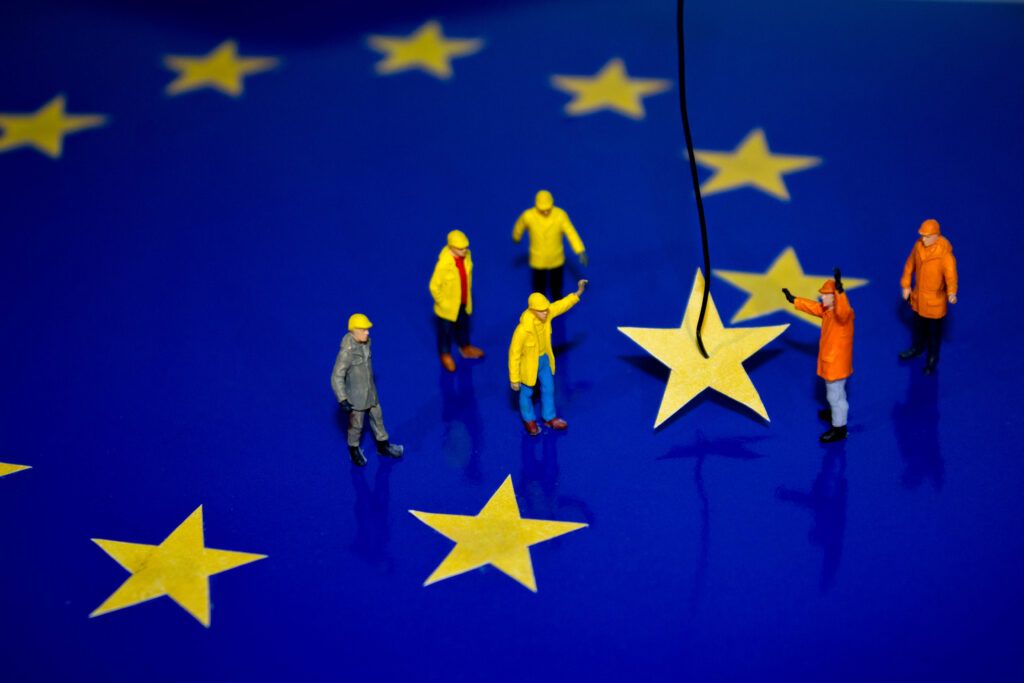
Strengthen the EU's oceanic diplomacy and international governance based on rules
And sixthly, the Pact points to the idea of strengthening the EU's ocean diplomacy and international governance, promoting international cooperation and global governance, based on regulations and agreements. It thus seeks to promote active diplomacy in multilateral spaces such as the United Nations.
Among the key actions is a new external strategy on fishing, with collaboration agreements based on sustainability. Regulation (EU) No. 1026/2012 will be adapted to act against unsustainable fishing and the ratification of the BBNJ Agreement will be promoted, supporting its application in developing countries with a contribution of 40 million euros. The entry into force of phase 1 of the WTO agreement that prohibits harmful fishing subsidies will also be promoted, advancing toward the conclusion of phase 2. From 2026, the use of the IT CATCH digital system will be mandatory to certify catches and combat illegal fishing (IUU).
Bou also warns that "we have a very complex institutional structure, with many entities with diverse competencies, and this makes decision-making and policy implementation difficult".
Therefore, what is intended with this pact is to lay the foundations and position the members that comprise it to not only conserve and recover the oceans, but also take advantage of their potential responsibly and thus ensure a sustainable and competitive future for Europe. This will allow creating a "Union of the Oceans".
- It is planned that in 2027 an Ocean Law will be drafted, with the pertinent objective of facilitating its application, in addition to forming a high-level "ocean council" to support the commission.
For the pact to become a real commitment, according to Bou, "first a focal point is needed to oversee its deployment, to guarantee alignment between the different strategies. It is also essential to promote concrete projects that already respond to the Pact's objectives".
Selection of binding objectives related to the ocean in EU legislation
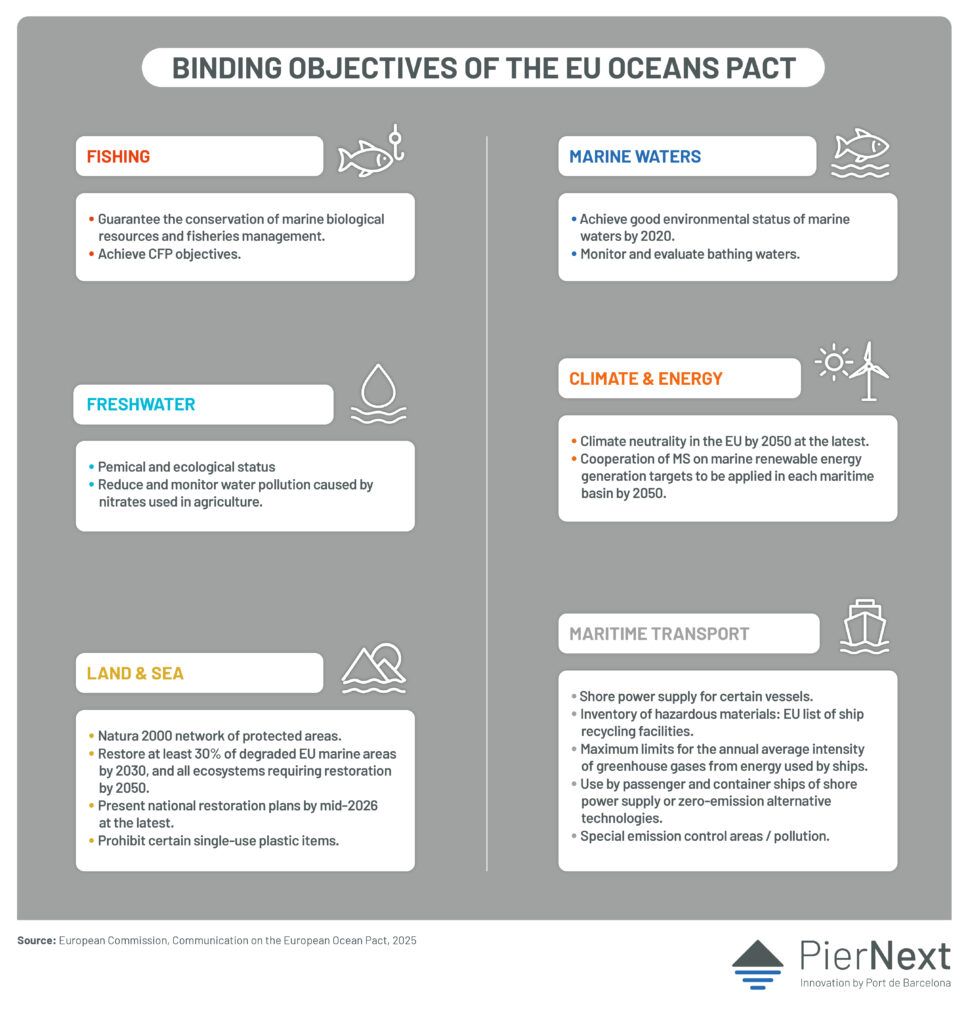
How Will the European Ocean Pact Affect Ports?
Ports are the gateway to the oceans, so they become strategic infrastructures. Places where maritime defense and security will have a key role within the framework of the European Union's Maritime Security Strategy. Coastal surveillance, international maritime cooperation will be strengthened and technologies such as drones, sensors and real-time surveillance systems will be promoted to protect critical infrastructures and submarine cables.
- Where ports will also be relevant is in blue innovation. All innovation, literacy and other research practices will find ideal testing centers in ports. Networks of ocean technology testing centers are planned to be created, linked to the digital replica of the ocean, to the Horizon Europe program and to initiatives such as the mission "Restore our ocean and our waters".
- Furthermore, they will have a key role in the blue economy. They are capable of energizing the blue economy throughout their region, acting as industrial, logistical and energy hubs. Many are already transforming into decarbonization, circularity and digitalization nodes. For this, they will have financial support through programs such as BlueInvest, InvestEU or the future KIC water, marine and maritime sectors, which will mobilize public and private investments toward greener infrastructures, alternative energies and sustainable fuels.
This pact wants to directly impact the blue economy, in the EU's domain. With ports as facilitators to implement the actions. A new port strategy for the European Union is also planned, currently under development, aligned with the future Ocean Law, which will strengthen their role in maritime spatial planning and promote their integration with other sectors such as fishing, energy or environmental conservation.





